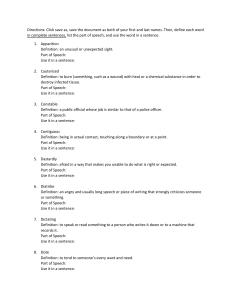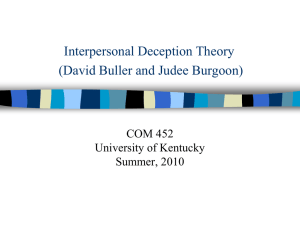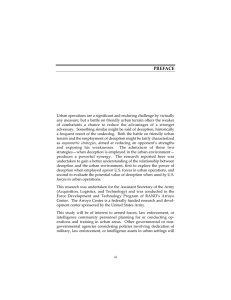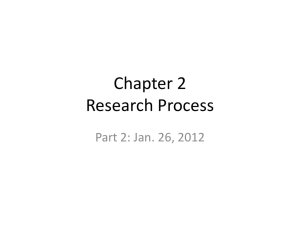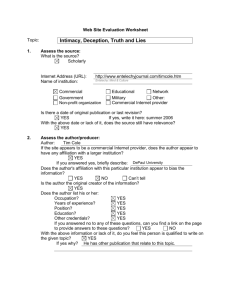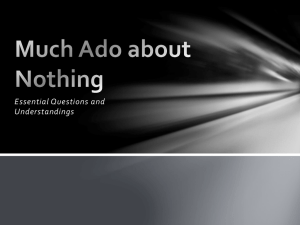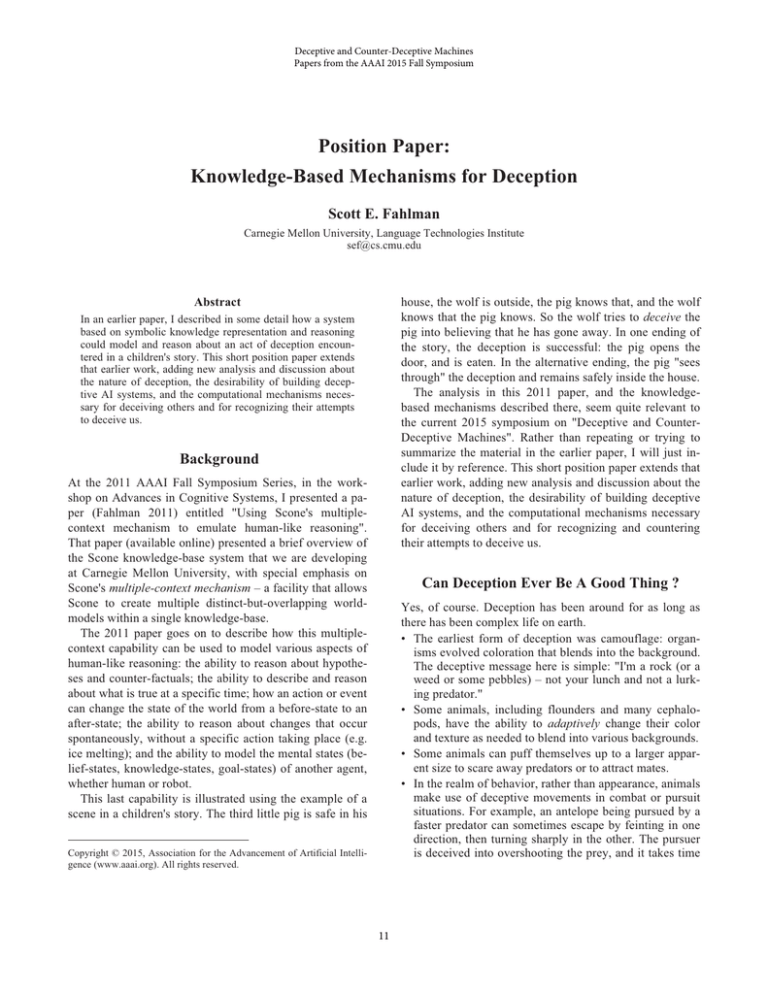
Deceptive and Counter-Deceptive Machines
Papers from the AAAI 2015 Fall Symposium
Position Paper:
Knowledge-Based Mechanisms for Deception
Scott E. Fahlman
Carnegie Mellon University, Language Technologies Institute
sef@cs.cmu.edu
house, the wolf is outside, the pig knows that, and the wolf
knows that the pig knows. So the wolf tries to deceive the
pig into believing that he has gone away. In one ending of
the story, the deception is successful: the pig opens the
door, and is eaten. In the alternative ending, the pig "sees
through" the deception and remains safely inside the house.
The analysis in this 2011 paper, and the knowledgebased mechanisms described there, seem quite relevant to
the current 2015 symposium on "Deceptive and CounterDeceptive Machines". Rather than repeating or trying to
summarize the material in the earlier paper, I will just include it by reference. This short position paper extends that
earlier work, adding new analysis and discussion about the
nature of deception, the desirability of building deceptive
AI systems, and the computational mechanisms necessary
for deceiving others and for recognizing and countering
their attempts to deceive us.
Abstract
In an earlier paper, I described in some detail how a system
based on symbolic knowledge representation and reasoning
could model and reason about an act of deception encountered in a children's story. This short position paper extends
that earlier work, adding new analysis and discussion about
the nature of deception, the desirability of building deceptive AI systems, and the computational mechanisms necessary for deceiving others and for recognizing their attempts
to deceive us.
Background
At the 2011 AAAI Fall Symposium Series, in the workshop on Advances in Cognitive Systems, I presented a paper (Fahlman 2011) entitled "Using Scone's multiplecontext mechanism to emulate human-like reasoning".
That paper (available online) presented a brief overview of
the Scone knowledge-base system that we are developing
at Carnegie Mellon University, with special emphasis on
Scone's multiple-context mechanism – a facility that allows
Scone to create multiple distinct-but-overlapping worldmodels within a single knowledge-base.
The 2011 paper goes on to describe how this multiplecontext capability can be used to model various aspects of
human-like reasoning: the ability to reason about hypotheses and counter-factuals; the ability to describe and reason
about what is true at a specific time; how an action or event
can change the state of the world from a before-state to an
after-state; the ability to reason about changes that occur
spontaneously, without a specific action taking place (e.g.
ice melting); and the ability to model the mental states (belief-states, knowledge-states, goal-states) of another agent,
whether human or robot.
This last capability is illustrated using the example of a
scene in a children's story. The third little pig is safe in his
Can Deception Ever Be A Good Thing ?
Yes, of course. Deception has been around for as long as
there has been complex life on earth.
• The earliest form of deception was camouflage: organisms evolved coloration that blends into the background.
The deceptive message here is simple: "I'm a rock (or a
weed or some pebbles) – not your lunch and not a lurking predator."
• Some animals, including flounders and many cephalopods, have the ability to adaptively change their color
and texture as needed to blend into various backgrounds.
• Some animals can puff themselves up to a larger apparent size to scare away predators or to attract mates.
• In the realm of behavior, rather than appearance, animals
make use of deceptive movements in combat or pursuit
situations. For example, an antelope being pursued by a
faster predator can sometimes escape by feinting in one
direction, then turning sharply in the other. The pursuer
is deceived into overshooting the prey, and it takes time
Copyright © 2015, Association for the Advancement of Artificial Intelligence (www.aaai.org). All rights reserved.
11
to recover. The feints are probably reflexive – not consciously planned.
In every case, these deceptive acts or attributes confer
some survival advantage on the deceiver – that's why these
capabilities evolve and why they persist in the population.
The deceiver's advantage usually comes at the expense of
the "victim", so there is also a selective advantage in being
able to identify or "see through" some deceptions.
For this workshop, we will focus on behavioral deception at the cognitive level – that is, deception that is deliberately planned and executed. While some animals may be
capable of this, we will focus on deception between adversaries who both possess human-like cognitive ability.
At first glance, it might seem crazy to build a capability
for deception into our robot servants. Do we want an autonomous car to lie to us about how it was dented or why it
was out driving around on its own between midnight and
4am? Probably not. There is (or should be) no adversarial
relationship here, so it is best for everyone if the robots are
truthful.
But as soon as these machines start acting in an adversarial environment – combat, diplomacy, a game of some
kind, or even a negotiation over price – deception suddenly
becomes an important tool for achieving the machine's (or
rather, its owner's) goals. In the case of a military drone,
the ability to confuse an adversary about its status and intentions may be essential both for completion of the mission and for the drone's own survival.
ventional moral strictures regarding this act are different
from a deception, even if D's belief is sincere but mistaken.
Note also that if action A is in the form of saying something rather than doing something, we call this action a
"lie" – but only if the statements made by D are literally
and unambiguously untrue. If they are just misleading,
perhaps because D is presenting true statements very selectively, we generally don't call this "lying" or "fraud" – it's
"persuasion" or "spinning". Again, the conventional moral
and legal strictures are different. An actual lie, under some
circumstances (e.g. testifying under oath) can be punished
as perjury, but "misleading" generally is a lesser offense.
If the motivation for D's description is benign or at least
not harmful to T – perhaps D wants to spare T some pain
or embarrassment, or wants to prevent T from doing something rash – we may call this a "good lie" or a "little white
lie". Some people may view this as a moral transgression,
but most people would forgive this as long as D's motive is
not to gain some advantage at T's expense.
All of these variations are cousins in the hierarchy of action types. They all involve D trying to alter the mental
state of T, but there are crucial differences in how society
views these actions, depending on motive, method, and
circumstances.
In the context of a game – simulated reality – the social
rules are different. It is impossible to consistently do well
at a multi-player game like poker or the board game Diplomacy without engaging in frequent and blatant deception. Even when playing for real money, deception is considered acceptable behavior – "all part of the game" – and
it is not supposed to affect the level of trust between D and
T in the real world, outside of the game context.
An interesting issue, beyond the scope of this paper, is
what happens if the same agents interact repeatedly in an
adversarial context, whether in a series of games, business
dealings, or combat. In this case, deceptive behavior in one
situation may be remembered and may affect behavior in
later dealings. An agent may develop a reputation for honesty, general deceptiveness, or for preferring certain kinds
of deceptive maneuvers such as bluffing. This reputation
itself may become something that the agent tries to manipulate. This is an area where qualitative AI reasoning meets
game theory – an interesting area for further research.
Manipulation of Mental States
Fundamentally, this cognitive-level deception is a matter of
modeling and manipulating your opponent's mental state. If
we say that agent D (the "deceiver") takes action A to deceive agent T (the "target"), we mean, more or less, this:
• Initially, both D's mental state and T' s mental state correctly represent the real world, or at least those aspects
of the true world-model that are important in this situation.
• D performs action A – that is, D says or does something
– that is intended to induce T' s to modify his mental
state so that it no longer corresponds to reality.
• T's new mental state is in some way advantageous to D
– for example, it may cause T to open a door when D, a
hungry wolf, is outside.
• If action A has the desired effect on T' s belief-state,
then we say that the deception was successful; if T does
not make the mental change that D desires, the deception
was unsuccessful – in other words, T didn't "fall for" the
trick.
Note that if D actually believes that the target mental
state for T is correct in reality, then we don't call this "deception" – we call it "education" or "persuasion". The con-
Required KRR Mechanisms for Deception
If deception is all about actions that affect mental states,
and if we want to represent and reason about deception, we
need a knowledge representation and reasoning (KRR) system that can easily represent a large number of mental
states (distinct world models), keeping them all in memory
at once without confusion, moving between them easily.
12
necessarily an optimal planner, but one that is flexible
enough to consider many alternatives and to polish the resulting plan until there is a reasonable chance that the plan
will succeed and that the police will be deceived about
what actually happened – who did it, how, why, and
whether any crime was committed at all.
Such a planner requires a great deal of worldknowledge, both static (entities, properties, and relations),
and recipes or plan-templates that can suggest an action
sequence for accomplishing some goal. The planner also
requires the ability to simulate (down to some level of detail) the results of executing the steps in a plan, in order to
do as much debugging as possible before trying to execute
the plan in the real world.
So, if D wants to poison someone, he must first have
some knowledge of poisons: which ones are reliable, how
long they take to act, how they are administered, how to
obtain them without leaving a clear trail, and which poisons are easy for the police or the coroner to detect after
the fact. It also helps if D knows which poisons have alternative uses that are both plausible and non-criminal, in
case he is caught with the poison.
D may want to claim that he was at home at the time of
the murder and that his car never left the garage. But if it's
a rainy night and the car is in the garage, dripping wet,
when the police arrive, this apparent contradiction may
lead them to doubt D's story. D may anticipate this and dry
the car before the police arrive, or he might leave it outside
in the rain, so that its wet state is not an anomaly.
So in addition to a good knowledge of poisons, D's
planning process must also have more mundane, commonsense knowledge about a vast range of topics – in this case,
cars, garages (which have roofs), rain, things getting wet,
how long things take to dry, that water on a car is more
easily visible than, say, some unique kind of mud on the
tires, and so on.
In this case, the police investigator is playing the role of
T, the intended target of the deception. What reasoning
mechanisms and strategies does T require in order to detect
and understand the deception?
I would argue that the capabilities needed by T are almost the same as those needed by D: world-knowledge
both general and domain-specific (e.g. poisons); a library
of action-types and their effects; a library of plan recipes
that T can try to fit to the case at hand, and a planner that
can produce various alternative plans that D might have
employed, or attempted to employ. That is, T must have
the same planning capabilities as D (or better) in order to
reconstruct what D may have been doing and why.
An additional capability needed by T, but perhaps not by
D, is a plan-recognition capability: given a few observed
steps in someone else's plan, what is the larger plan within
which these steps appear, and is that plan plausible in the
current context?
Scone's multiple-context model was designed specifically to deal with this kind of problem. Each mental state
(knowledge-state, belief state, goal state, hypothesis, etc.)
is represented by a distinct Scone context. The way these
contexts operate is described in the 2011 paper, so I will
not repeat that here. But I believe that the critical requirements for the knowledge base of a deceptive of counterdeceptive agent are as follows:
First, it must be a lightweight operation, both in memory
and in processing time, to create a new context, so that we
can afford to have many of them around at once. More
specifically, it must be easy to create a context X that is
"just like" existing context Y, except for some explicitly
stated differences – both additions of new entities and
statements that are only present in X, and cancellation of
some things in Y that would otherwise be inherited by X.
Second, a context must function both as a container – a
world model within which we can perform queries and inferences – and as a full-fledged entity in the knowledge
base. This allows us to use the full expressive power of the
knowledge-base system (KBS) to talk about an entire hypothesis or world-view. Within an agent's KBS, some context or set of contexts will be labeled as that agent's current
true beliefs, some may be possible but uncertain beliefs,
and some may be pure fiction.
This suggests that, as a minimum, we need default reasoning with explicit exceptions, and we need higher-order
logic so that statements about statements are allowed, nested to any level. Scone's multiple-context mechanism is
just a convenient way of re-packaging higher-order logic.
It is hard to see how a system based on first-order logic or
a less-expressive subset of FOL could get any real traction
in dealing with deception and mental states.
Reasoning Strategies for Deception and
Counter-Deception
Scone-like mechanisms for representation and fast simple
inference may be necessary enabling technologies for
complex deception or counter-deception, but of course this
is not the whole story. Built upon this substrate of
knowledge, making heavy use of it, are the higher-level
reasoning mechanisms and strategies that actually plan and
refine the deceptive words or actions, or that try to diagnose whether any deception is taking place.
What reasoning mechanisms and strategies are required?
For now, let's focus on complex deceptions of the kind we
see in detective stories. These illustrate the full range of
mechanisms required. Simpler deceptions – a single lie
about a single event – will often need many of these mechanisms as well.
Planning a complex deception – let's say a crime – requires that D's mental machinery includes a planner – not
13
approximate, partial matching.) That old case may suggest
a framework for what is really going on – a template that
can be modified to fit the case at hand. These stored cases
may be kept in more-or-less raw form, or they may have
undergone some pre-processing to generalize them and
create meta-information about them. Either way, a wealth
of stored experiences can be valuable.
I should emphasize that this analysis of the reasoning
strategies is all speculative, as of now. In the Scone research group, we have discussed these things, but we have
not yet actually tried to build any deceptive AI systems. As
argued in this paper, there is a lot of machinery required to
plan and execute complex deceptions, but the striking thing
is how little of this machinery is needed only for deceptive
and counter-deceptive reasoning.
There is great overlap between the mechanisms I have
described here and the mechanisms we are building for cooperative, truthful human-robot interaction in domains
such as vehicle maintenance. In both cases we need a KB
with a multi-context mechanism, static domain knowledge,
a library of recipes (plan templates) for accomplishing various goals in the domain, a planner that can make use of
these recipes, and a (mostly qualitative) simulator against
which to test our plans before we try them in the real
world. (Once we start executing the plan it may be difficult
or impossible to back up and undo some actions already
executed.) In cooperative human-robot scenarios, we need
the capability to model the goal-states and belief-states of
the other agents in order to predict what these agents will
do, and we need the capability to recognize their intentions
from a few observed actions. We may occasionally need to
intervene in the mental state of other agents (i.e. tell them
something) in order to prevent wasted effort.
So it would appear that same substrate of fundamental
representation and reasoning mechanisms are needed for
real-world problem-solving, for multi-agent cooperation on
tasks, and for deception and counter-deception. Only the
adversarial reasoning and a few of the higher-level strategies seem to be unique to the deception domain.
So, if D was seen putting on a ski mask on the night of
the murder, and if it is rainy but not particularly cold outside, D probably is worried that he might be seen and
wants to make sure that his face cannot be identified. So
that is probably a part of D's larger plan. There has been a
lot of research in the robotics world on plan identification –
this just takes it to a more abstract and much more complex
domain.
For both the deceiver D and the counter-deceiver T,
there is a requirement for adversarial reasoning – the kind
that we see in chess programs: "If I make move M1, your
best counter-move is … after much computation … M2,
and then my best move on this branch is M3" and so on. It
is important for D to consider the actions T might take to
gather additional evidence. Of course, chess is a game of
perfect information and has a very small, bounded set of
options at each level. Real-world adversarial reasoning is
much more complex, so considering every possibility is
impossible. These agents don't have to be perfect – just
better than their adversary.
A skilled deceiver D will first perhaps sketch his plan,
then try to simulate how that plan will look to T. If there
are incongruities that T is likely to notice, weakening the
credibility of the deception, then D can try to modify the
original plan. So if D anticipates that it may be raining and
that T will notice the wet car, D can modify the plan to include drying off the car. Ah, but T might obtain a search
warrant and find the wet towels, so D further modifies the
plan to get rid of the towels, somewhere off the premises,
before T arrives (but D can't use his car to do this). And so
it goes, each agent trying to consider all the likely possibilities and each trying to anticipate the other's actions and
thought processes.
Conclusions
None of the reasoning here is straightforward logical deduction. D is trying to construct a deception that, while not
guaranteed to work, is unlikely to lead T to conclude that a
deception is taking place. T is looking for the most-likely
or most-plausible interpretation for what is going on. In a
criminal investigation, T may be looking for "proof" of D's
deception, but this is not a mathematical "proof" – it is just
enough to persuade a jury "beyond a reasonable doubt" that
T's version of the story is the only plausible one, and that
D's alternative version is not truthful. So the reasoning described here is much more like abductive reasoning
(searching for the most likely cause for some observed
state of the world) than like a formal deductive proof.
This also may involve a form of case-based reasoning.
The elements of a case may remind T of a specific case
that he has worked on before, or perhaps just heard about.
(For this to happen, the knowledge base must be good at
Acknowledgments:
The work reported here was supported in part by the U.S.
Office of Naval Research, under grant N000141310224.
Any opinions, findings, conclusions, or recommendations
expressed here are those of the author, and do not necessarily reflect the views of ONR or the U.S. government.
References
Fahlman, S. E. 2011. Using Scone’s multiple-context mechanism
to emulate human-like reasoning, Proceedings of the AAAI Fall
Symposium
on
Advances
in
Cognitive
Systems.
http://www.cs.cmu.edu/~sef/scone/publications/ACS-2011.pdf
14



